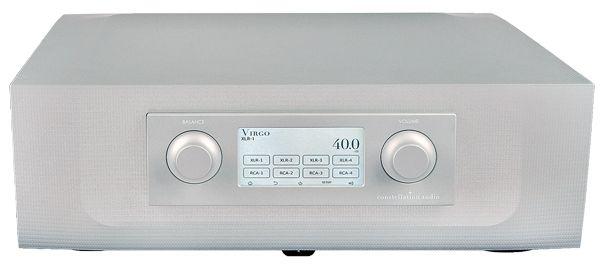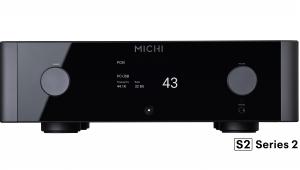Constellation Virgo/centaur Mono (virgo £19,000; Centaur (each) £26,750)

The Virgo preamplifier and Centaur monoblocks reviewed here are models from Constellation’s ‘economy’ Performance range, yet total £72,500. As for Reference prices, we shudder to think…
While a pretty enough design, the Virgo is rather anodyne, its greyness John Major-like. A plain-Jane outboard power supply feeds it via two umbilical cables, connecting at the back where you find rows of both XLRs and phono sockets for every input and output – four sources, two sets of outputs and RS232 and USB inputs for networks and firmware upgrades.
At the front, the central panel’s 432x230-pixel screen is flanked by rotaries for balance and volume, while other operations are accessed through menus activated by a row of buttons under the display panel.
These include muting, power on from standby, ‘home’ to return to the basic screen, display intensity, input selection and the setting of input levels. The nicely-made aluminium remote control offers standby, mute, volume up/down, source selection, balance and phase inversion. The fascia volume control we found irritating. Nothing about it is especially intuitive and even the display all but hides the minus sign next to the digits showing the level setting. As for the speed of raising and lowering the volume, we never got used to that, so reverted to the remote control whenever possible.
As for the Centaur monoblocks [not pictured], they’re huge, and they like free space around them, though nothing ever grew hot to the touch. These are seriously powerful, single-ended FET amplifiers at a factory-rated 500W apiece into 8ohm, with a switch-on regimen to ensure that nothing nasty happens to your speakers.
A rounded sound
At the back, you have a choice of single-ended or balanced operation, but you have two options for the latter: ‘Balanced’ for use with non-Constellation preamps and ‘Direct’ for use with a Virgo or one of its siblings. We tried both, and got different results, so we’re (1) at a loss to state which is ‘better’, but (2) overjoyed to note that in both cases, the changes were audible enough to leave no doubt as to which was better.
In one system, using Magico S5s, ‘Direct’ was preferred. In the editor’s system, with his B&W 802s, ‘Balanced’ proved superior.
With ‘God Only Knows’ on If You Leave… [Moscodisc] and the ‘Balanced’ setting, Eleanor McEvoy was in the room, with ghostly, eerie authenticity. The palpability was almost disturbing, simply because the realism was of an order rarely achieved in sound reproduction.
Another exquisite female voice followed that sparse, unplugged session, Eva Cassidy’s gorgeous ‘People Get Ready’, from Best Of Eva Cassidy [Blix]. It oozed atmosphere. Most impressive was the drumming, crisp and solid, with weight and scale, behind those soaring vocals. A fragile guitar stage-left created a gossamer-light melody, perfectly complementing the cymbals’ wispiness. The cohesion was remarkable for a live recording.
With all that power on tap, we just had to dig out Kodo’s Warabe [Sony], the opener ‘Yokigen’ featuring relentless drumming that immediately evokes some battle scene in a Kurosawa epic. The Centaurs are no slouches when it comes to slam, but the delight was the roundness to the sound, a quality that imparted the sense that the air being moved was of a greater quantity than the woofers could ever manage. With flute hovering over the drums, the Constellations juggled delicacy and force simultaneously, favouring neither of these over the other.
Verdict
The price is forbidding, the size off-putting, the preamp ergonomics the antithesis of ‘real-time’, tactile rotaries. But what you’ll hear is as close to the source as it gets. A notable triumph by any standards.
Originally published in the 2013 Yearbook
























































